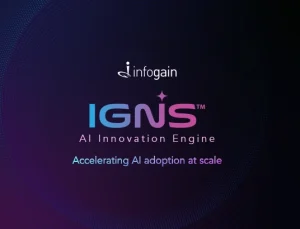- Posted on : September 21, 2022
-
- Industry : Corporate
- Type: Blog

Climate change is real. Controlling carbon emissions is key to addressing it. But that can’t mean fixating on one factory’s smokestack or a solo driver’s exhaust pipe.
The global IT industry plays an important role. From business strategy consulting and deep data analytics to creating sustainable IT architectures and implementing them, there is a wide range of opportunities to help companies establish the eco-credentials demanded by clients, investors, and auditors.
Technologies like Artificial Intelligence, cloud, 5G, Internet of Things, analytics, automation, drones, and sensors can help cut global emissions by half by 2030 while driving exponential growth in data performance.
- Cloud solutions help reduce carbon emissions by managing power capacity, optimizing heating and cooling in structures, and leveraging power-efficient servers.
- AI platforms and software will uncover patterns in how resources are used that humans might have missed to recommend new solutions.
- Automation of processes and data systems allows organizations to reduce their energy needs with production efficiencies.
- IoT sensors can make heating and cooling systems smart in metering and forecasting.
- Predictive analytics improve transportation and supply networks to reduce interruptions and miles traveled.
Establishing a circular economy – in business, countries, or the world – requires adhering to three principles.
- Eliminating waste and pollution
- Reusing goods and resources
- Regenerating natural systems
IT plays an important role by using existing technology and refining it in ways not limited to managing information. How companies collect and use data requires computing power, which requires a lot of energy. Changes to data-center infrastructure can improve energy efficiency. Segregating garbage at the source and using approved recyclers can ensure hazardous and electronic material doesn’t end up in landfills. And in other industries, IT can help with monitoring – which leads to changing procedures.
Joining the initiatives, meeting the goals
The Science-Based Targets initiative has validated carbon reduction targets set by several companies. Enterprises are forming separate business teams focusing on different methodologies to minimize the global impact. They are utilizing groups efficiently alongside operational excellence, creative assets, and added-value alliances to continuously enhance the implementation of Environment, Social, and Governance (ESG) goals.
With more than 10 million data points covering up to 99% of the activities, carbon accounting systems offer complete data sets regarding carbon footprint. This data is gathered and evaluated yearly. With this vast data collection, greenhouse gas emissions can be seen at a very fine scale to identify areas where emissions can be cut.
Innovation plays a crucial role in shaping the custom solutions clients’ net-zero strategies require. Whether those strategies require switching to renewable electricity, electric vehicle use, supplier engagement, maintaining a focus on sustainable workplace design, digital collaboration – or more likely an approach that combines these methods with others.
The Client Carbon Impact Calculator and associated methodologies provide a precise carbon impact of client projects. The opportunities for change are tremendous, focusing on positive and negative carbon impacts in business travel, home working, commuting, office energy consumption, and the digital or data center footprint.
With the right policy frameworks and guidelines in place, such technologies can be instrumental in moving society towards a circular and lean economy focused on growing service value while reducing waste and pollution.
As the world enters the fourth phase of the Industrial Revolution, sustainable digital technologies will be required simultaneously to make the world a better place to live.
Infogain is committed to reducing per capita carbon footprint by reducing energy consumption across our offices, writing low consumption codes, and consistently sensitizing our team on efficient energy utilization through various training programs.
We have also contributed to the Environmental Defense Fund’s (EDF) MethaneSAT satellite project, which measures methane emissions around the world, giving industry, investors, and regulators an essential tool to spot problem areas, identify reductions and measure progress.







